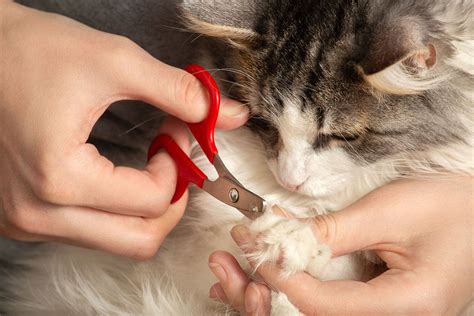Introduction

Cats’ nails are an essential part of their anatomy, serving various purposes such as climbing, scratching, and defense. However, overgrown or untrimmed nails can lead to a number of health issues, including discomfort, pain, and infection. Regular nail care and trimming are crucial for maintaining your cat’s well-being.
Understanding Cat Nails
Cat nails consist of two layers: a hard, outer layer known as the claw, and a soft, inner layer called the quick. The quick contains nerves and blood vessels, making it sensitive and prone to bleeding if cut. It’s important to note that only the outer claw should be trimmed, avoiding any contact with the quick.
Why Nail Trimming is Important
Overgrown nails can cause several problems for your cat:
- Discomfort and pain: Long nails can dig into your cat’s paw pads, causing discomfort and hindering their movement.
- Injury: Untrimmed claws can grow too sharp, posing a risk of injury to both your cat and others.
- Infection: Long nails can trap dirt and bacteria, leading to nail infections that can cause pain and inflammation.
- Furniture damage: Cats may scratch furniture to wear down their nails, resulting in damage to your belongings.
Frequency of Trimming
The frequency of nail trimming varies depending on your cat’s individual needs and lifestyle. Generally, it’s recommended to trim every 2-3 weeks, or more frequently if your cat is active or has a tendency to scratch excessively.
Tools for Trimming
There are several types of nail trimmers available specifically for cats:
- Scissor-style trimmers: Designed with small blades that can precisely cut the claw without damaging the quick.
- Guillotine-style trimmers: Feature a sharp blade that slides through the claw, similar to a guillotine.
- Electric trimmers: Use a rotating blade to grind down the claw, reducing the risk of cutting into the quick.
Step-by-Step Trimming Instructions
- Gently restrain your cat: Wrap your cat in a towel or blanket to secure them during the trimming process.
- Find the quick: Identify the pink area inside the nail, which represents the quick. Avoid trimming into this area.
- Trim only the sharp tip: Use the nail trimmers to cut off the sharp tip of the claw, staying clear of the quick.
- Shape the nail: Lightly file any sharp edges or burrs on the nail using a nail file or grinder.
- Repeat for all nails: Trim all of your cat’s nails, including the dewclaws on the front paws.
Alternatives to Trimming
If you are unable to trim your cat’s nails yourself, there are alternative options available:
- Scratching posts: Encourage your cat to scratch on designated scratching posts to wear down their nails naturally.
- Nail caps: These soft, rubber caps can be glued onto the tips of your cat’s nails to prevent them from scratching.
- Professional grooming: Take your cat to a professional groomer or veterinarian to have their nails trimmed.
Nail Care Tips
In addition to trimming, there are several other aspects of nail care that are important for your cat’s health:
- Regular inspection: Check your cat’s nails regularly for any signs of breakage, infection, or excessive growth.
- Clean paws: Wipe your cat’s paws with a damp cloth to remove dirt and debris that can accumulate around the nails.
- Prevent nail biting: Discourage your cat from biting their nails, as this can weaken them and make them prone to breakage.
FAQs
-
How can I tell if my cat’s nails are overgrown?
Overgrown nails will extend beyond the paw pad and may curl or hook inward. They can also make a clicking sound when your cat walks. -
What should I do if I accidentally cut into the quick?
If you cut into the quick, immediately apply pressure to the nail to stop the bleeding. You can use a styptic powder or a clotting agent to speed up the process. -
Can I trim my kitten’s nails?
Yes, it’s important to start trimming your kitten’s nails from an early age to establish a positive association with the process. -
How often should I trim my cat’s dewclaws?
Dewclaws are located on the inside of the front legs and do not wear down as quickly as the other nails. Trim them every 4-6 weeks to prevent them from becoming overgrown. -
What if my cat resists nail trimming?
If your cat resists nail trimming, try using treats or praise to encourage them. You can also gradually desensitize them by gently touching their paws and nails. -
Can I use human nail clippers to trim my cat’s nails?
No, human nail clippers are not designed for cat nails and can crush them, causing discomfort or injury.
Conclusion
Regular nail care and trimming are essential for maintaining the health and well-being of your cat. By understanding your cat’s nail anatomy, following the proper trimming techniques, and addressing any concerns or questions, you can ensure that your furry companion has healthy, comfortable nails for life.





















